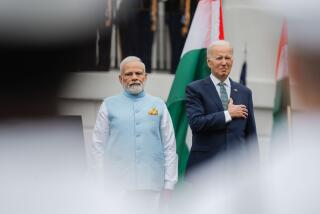India not sold on closer military ties with U.S.
- Share via
NEW DELHI — Defense Secretary Leon E. Panetta urged India on Wednesday to build a closer military relationship with the United States, but Indian leaders appeared more interested in buying U.S. weapons than in aligning strategically with Washington.
Senior Indian officials made it clear in two days of talks that they will continue to set their own course on U.S. national security priorities, including isolating Iran and building upAfghanistan’smilitary forces, sometimes in tandem with Washington and sometimes not.
Panetta is visiting Asia this week to bolster military ties as the Obama administration, wary ofChina’s growing clout in the region, seeks to reassert America’s presence in the Pacific after a decade of war in Iraq and Afghanistan.
The Pentagon chief described enhanced defense cooperation with India as “a linchpin” of the new strategy. But India has charted an independent foreign policy for decades, and its response was decidedly cool.
Panetta held meetings with Prime Minister Manmohan Singh, Defense Minister A.K. Antony, National Security Advisor Shivshankar Menon and other government officials. But he did not hold a joint news conference with his Indian counterpart, as he usually does when he visits friendly countries.
“We’ll never be an alliance partner with the U.S.,” said Lalit Mansingh, an analyst and a former Indian ambassador to Washington. “The limit is a partnership.”
The Pentagon has stationed tens of thousands of troops, plus aircraft and warships, at bases in Japan and South Korea since the end of World War II. But the U.S. withdrew from most of Southeast Asia after the Vietnam War ended in 1975, and major bases in the Philippines closed in the early 1990s.
The U.S. maintains a large Navy ship and submarine support facility and air base on Diego Garcia, a British-controlled atoll in the Indian Ocean. It has no bases in India.
The new strategy aims to restore aU.S. militarypresence across the Asia-Pacific region, but not by building permanent bases or deploying large forces.
Instead, Panetta emphasized, the United States seeks to build up the militaries of friendly governments with arms sales and joint training with U.S. forces deployed on short rotations. The message was meant to reassure Indian officials, who are eager to modernize their armed forces but not to appear too cozy with Washington.
“Our vision is a peaceful Indian Ocean region supported by growing Indian capabilities,” Panetta said in a speech at the Institute for Defense Studies and Analyses, a think tank associated with the Indian military. “America will do its part … but the fundamental challenge is to develop India’s capabilities so it can respond to challenges.”
U.S. officials have said publicly that the new strategy is not aimed at confronting China, but Panetta’s trip took him to India and Vietnam, two of China’s historic rivals. Both nations have border and territorial disputes with Beijing and concerns about its expanding military might.
Senior officials traveling with Panetta said they hoped India would take a greater role in training Afghan army and police forces as the U.S. and its allies withdraw combat troops from Afghanistan over the next 2 1/2 years.
India brings a small number of Afghan officers to its military academies for instruction. It has balked at sending Indian troops to Afghanistan, even as trainers.
Panetta’s travel plans don’t include a stop in Pakistan, where CIA drone strikes this week killed Al Qaeda’s No. 2 leader. Pakistan has repeatedly condemned the drone attacks as a violation of its sovereignty. It has also refused to allow truck convoys to supply U.S. and NATO troops in Afghanistan since errant U.S. airstrikes killed 24 Pakistani soldiers in November, causing severe strains in relations.
In answer to a question at the think tank, Panetta was blunt about the problems between Islamabad and Washington.
“It’s a complicated relationship, oftentimes frustrating, oftentimes difficult,” he said. “They have provided some cooperation. There are other times when frankly that cooperation is not there. But the United States cannot just walk away from that relationship.”
He urged India to improve relations with its traditional rival. The nuclear-armed neighbors have fought three wars since 1947.
India is the world’s largest arms importer. Washington was disappointed last year when U.S. companies lost out on a $12-billion deal to sell 126 fighter jets to New Delhi.
India maintains that the U.S. offered older aircraft technology. Officials also bridle at what they see as U.S. reluctance to transfer other sensitive technology, and Washington’s insistence on after-sales, on-site inspections of equipment, part of U.S. policy to ensure sophisticated weapons aren’t diverted to rogue states.
There are some signs that New Delhi and Washington are finding some middle ground, analysts said.
Several arms deals in the pipeline, amounting to about $8 billion in sales, have been signed with U.S. companies, partially allaying concern on Capitol Hill that India isn’t fully committed to a defense relationship.
Both sides reportedly also are looking for ways to prevent diversion of sensitive technology without intrusive inspections.
More to Read
Sign up for Essential California
The most important California stories and recommendations in your inbox every morning.
You may occasionally receive promotional content from the Los Angeles Times.











